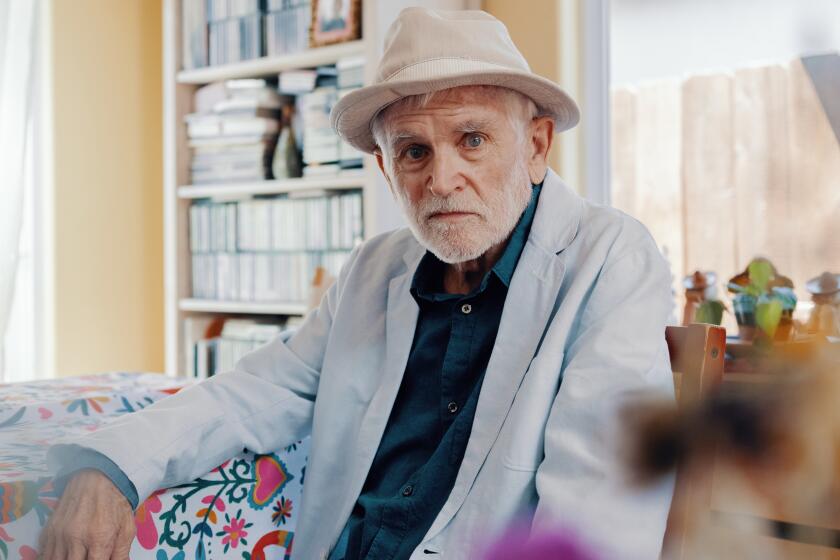A Foundling’s Misbegotten Quest for Love
- Share via
Imagination is one of the greatest antidotes to captivity. Whether one’s confinement is physical or psychological, the chance to wander mentally, to conjure an alternate existence for oneself, is every human being’s refuge against unhappiness.
For Dervla O’Shannon, the 13-year-old narrator of John Hawkes’ concise and atmospheric new novel, “An Irish Eye,” invention is both a balm against the Oliver Twistian deprivations of her life at St. Martha’s Foundling Home in Carrickfergus, Ireland, and at the same time a way to discover, perhaps to influence, her own fate. “I shall never be borne down by the mere truth of things,” she tells us early on. This remark is the closest that brash young Dervla comes to offering the reader a credo, even if by the end of the story she subtly but tellingly contradicts her own assertion.
Interestingly, Dervla’s fantasies are directed less to her past than to her present adventures. Although she acknowledges the power of “the enigma that is every foundling’s birthright . . . what I call the hollowness of our beginning,” Dervla spends little time lingering over the mystery of her origin. Her voice is distinguished more by comedy than by introspection. Part Pollyanna, part picaro, Dervla introduces us to the routine of her days under the care of the alternately beneficent and harsh Foundling Mother with an innocence that is not wholly convincing, particularly as the story advances.
“The life of a foundling is not so much,” Dervla remarks after this preamble. “But love is another thing altogether.” Dervla’s quest for love, misbegotten and poignantly absurd though it is, becomes the focus of her adventures after she and her fellow foundlings are taken to Carrickfergus’ Old Soldiers Home to provide entertainment for the dreary, superannuated veterans who (in one of the novel’s several clever echoes) are housed in an edifice every bit as grim as the Foundling Home.
During a dance at the Old Soldiers Home, Dervla is introduced to Corporal Stack, soon “Teddy,” who wears a gas mask and uniform and looks like “a waxen mannequin modeling the battle dress of the First World War.” Teddy apparently plays at--and plays up--his senility, however, and is soon spending his afternoons riding horses with the plucky young Dervla. One day, the pair escapes--as much into Dervla’s fantasy as away from their respective homes. Colluding with Mr. Lackey, the groomsman, Teddy and Dervla move into his livery stable, where Teddy plans to revel in the horses and Mr. Lackey plans to revel in Dervla.
In order to explain her absence, Dervla and Teddy contrive a “visit” to Teddy’s family farm, from which Dervla writes the Foundling Mother a series of letters that vividly display her capacity for fantasy.
*
As if in answer to Teddy’s request, the story twists yet again. Teddy has an accident while he and Dervla are out riding one day. The twosome is collected by a young woman and spirited off to the Great Manor, an Anglo-Irish house that is in gothic decay, complete with broken windows, moths in the curtains and curmudgeonly servants who swallow Dervla into their ranks while sequestering Teddy during his convalescence.
At the manor, Dervla is turned into a maid by the housekeeper, Mrs. Grant, who (reader: beware!) herself takes care of foundling children. Gradually even the faux naive Dervla notes the similarity between “what came unbidden onto the sheet of paper and what was now happening to me.” Unfortunately, the convolutions of Dervla’s incarceration at the manor seem increasingly arbitrary and not quite as comic as Hawkes intends them to be. One problem is Dervla’s voice, which becomes too self-aware; another is that her passivity seems illogical in so plucky and supple-minded a girl.
In its celebration of the imagination, however, “An Irish Eye” remains steadfast. Dervla is appealing foremost for her fantasies, which are linked by certain thematic attributes, chief among them incarceration, childless women who take in homeless children and the power of the Irish countryside.
Dervla initially maintains that she will not be weighed down by the mere truth of things, but it is precisely the truth of things, the reader discovers, that fires her creativity. Dervla’s imagination turns out to have more than a touch of the autobiographical in it, as perhaps the keenest imagination always does, and eventually it leads her and the reader to a deft if not terribly surprising conclusion to this gentle, imperfect tale.
More to Read
Sign up for our Book Club newsletter
Get the latest news, events and more from the Los Angeles Times Book Club, and help us get L.A. reading and talking.
You may occasionally receive promotional content from the Los Angeles Times.







